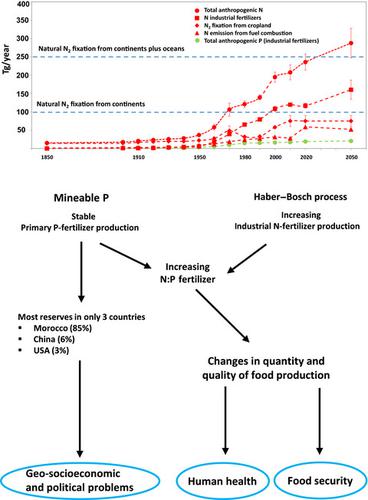当前位置:
X-MOL 学术
›
Glob. Change Biol.
›
论文详情
Our official English website, www.x-mol.net, welcomes your feedback! (Note: you will need to create a separate account there.)
Anthropogenic global shifts in biospheric N and P concentrations and ratios and their impacts on biodiversity, ecosystem productivity, food security, and human health.
Global Change Biology ( IF 11.6 ) Pub Date : 2020-01-08 , DOI: 10.1111/gcb.14981 Josep Penuelas 1, 2, 3 , Ivan A Janssens 4 , Philippe Ciais 5 , Michael Obersteiner 6 , Jordi Sardans 1, 2, 3
Global Change Biology ( IF 11.6 ) Pub Date : 2020-01-08 , DOI: 10.1111/gcb.14981 Josep Penuelas 1, 2, 3 , Ivan A Janssens 4 , Philippe Ciais 5 , Michael Obersteiner 6 , Jordi Sardans 1, 2, 3
Affiliation

|
The availability of carbon (C) from high levels of atmospheric carbon dioxide (CO2 ) and anthropogenic release of nitrogen (N) is increasing, but these increases are not paralleled by increases in levels of phosphorus (P). The current unstoppable changes in the stoichiometries of C and N relative to P have no historical precedent. We describe changes in P and N fluxes over the last five decades that have led to asymmetrical increases in P and N inputs to the biosphere. We identified widespread and rapid changes in N:P ratios in air, soil, water, and organisms and important consequences to the structure, function, and biodiversity of ecosystems. A mass-balance approach found that the combined limited availability of P and N was likely to reduce C storage by natural ecosystems during the remainder of the 21st Century, and projected crop yields of the Millennium Ecosystem Assessment indicated an increase in nutrient deficiency in developing regions if access to P fertilizer is limited. Imbalances of the N:P ratio would likely negatively affect human health, food security, and global economic and geopolitical stability, with feedbacks and synergistic effects on drivers of global environmental change, such as increasing levels of CO2 , climatic warming, and increasing pollution. We summarize potential solutions for avoiding the negative impacts of global imbalances of N:P ratios on the environment, biodiversity, climate change, food security, and human health.
中文翻译:

生物圈氮磷浓度和比率的人为全球变化及其对生物多样性、生态系统生产力、粮食安全和人类健康的影响。
来自高水平大气二氧化碳(CO2)和人为释放的氮(N)的碳(C)的可用性正在增加,但这些增加与磷(P)水平的增加并不平行。当前碳和氮相对于磷的化学计量发生不可阻挡的变化是没有历史先例的。我们描述了过去五年中 P 和 N 通量的变化,这些变化导致生物圈 P 和 N 输入的不对称增加。我们发现了空气、土壤、水和生物体中氮磷比的广泛而快速的变化,以及对生态系统的结构、功能和生物多样性的重要影响。质量平衡方法发现,P 和 N 的有限可用性可能会减少 21 世纪剩余时间内自然生态系统的 C 储存量,并且千年生态系统评估的预计作物产量表明发展中地区养分缺乏的情况加剧如果磷肥的获取受到限制。N:P比例失衡可能会对人类健康、粮食安全以及全球经济和地缘政治稳定产生负面影响,并对全球环境变化的驱动因素产生反馈和协同效应,例如二氧化碳浓度增加、气候变暖和污染加剧。我们总结了避免全球氮磷比例失衡对环境、生物多样性、气候变化、粮食安全和人类健康产生负面影响的潜在解决方案。
更新日期:2020-02-21
中文翻译:

生物圈氮磷浓度和比率的人为全球变化及其对生物多样性、生态系统生产力、粮食安全和人类健康的影响。
来自高水平大气二氧化碳(CO2)和人为释放的氮(N)的碳(C)的可用性正在增加,但这些增加与磷(P)水平的增加并不平行。当前碳和氮相对于磷的化学计量发生不可阻挡的变化是没有历史先例的。我们描述了过去五年中 P 和 N 通量的变化,这些变化导致生物圈 P 和 N 输入的不对称增加。我们发现了空气、土壤、水和生物体中氮磷比的广泛而快速的变化,以及对生态系统的结构、功能和生物多样性的重要影响。质量平衡方法发现,P 和 N 的有限可用性可能会减少 21 世纪剩余时间内自然生态系统的 C 储存量,并且千年生态系统评估的预计作物产量表明发展中地区养分缺乏的情况加剧如果磷肥的获取受到限制。N:P比例失衡可能会对人类健康、粮食安全以及全球经济和地缘政治稳定产生负面影响,并对全球环境变化的驱动因素产生反馈和协同效应,例如二氧化碳浓度增加、气候变暖和污染加剧。我们总结了避免全球氮磷比例失衡对环境、生物多样性、气候变化、粮食安全和人类健康产生负面影响的潜在解决方案。



























 京公网安备 11010802027423号
京公网安备 11010802027423号